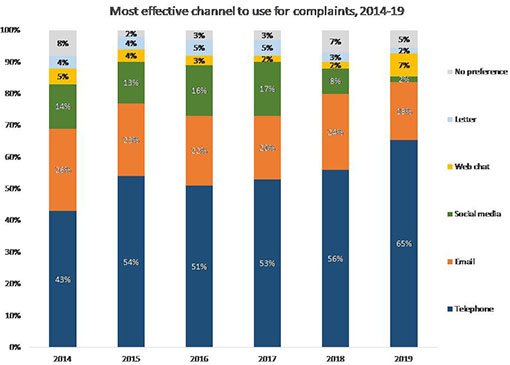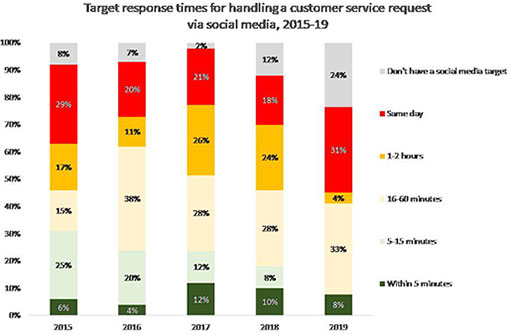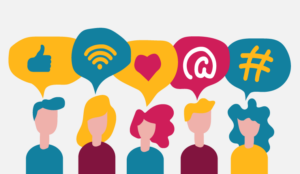Steve Morrell of ContactBabel discusses the challenges of social media customer service and the factors contact centres need to take into account.
Uniquely, social media has taken off as a customer service channel as a result of customer demand rather than businesses’ enthusiasm for promoting a cheaper service channel.
The rise of social media as a customer service channel has often been de facto, in that customers have actively sought out the company’s Facebook page or Twitter account to communicate with it, even if the company originally had a social media presence only to disseminate information.
In 2012, less than 1% of inbound interactions were through social media. Since then, there has been a steady if not spectacular rise, with 2019 seeing the highest level yet, at 3.1% (compared to webchat at 3.6%).
74% of UK contact centres expect social media interactions to grow in the next 12 months, which as a channel is second only to webchat (78%).
Despite the relatively low levels of customer interactions via social media, the high-profile nature of this channel and the possible magnifying effects of negative comments means that social media has been viewed as being far more important than baseline interaction statistics would suggest.
Some savvy customers, knowing that their public complaint or issue will be dealt with quickly, prefer to go straight to a social media channel rather than wait in a telephone queue. Others might choose the social channel after they’ve had a bad experience on another channel, such as waiting on hold for a phone agent.
Complaints
(Very) public complaints have become a significant part of social media interactions for businesses, and senior management is very aware of the issue.
For some customers, social media contact can provide a very positive experience with a very low pain point, and at virtually no cost of time or money: the customer complains, loudly and in public, so the business reacts quickly and effectively.
For the customer, this is great; it is the business for whom the popular methods of social media handling are not optimal. Not only do they have to carry out their business in public, reacting quickly and sometimes without being able to authenticate the customer’s identity, but they often cannot handle the query without resorting to another channel that provides more privacy and functionality.
This means that they are not even seen by the outside world to be reacting quickly and effectively, or to have solved the problem.

In the past couple of years, businesses’ fear of social media complaints seems to have abated somewhat.
The chart above shows the channels that contact centre management believes would be the most effective for customers to use: while telephony has always been viewed as no.1, social media was often seen as having far more clout than should have been its due when compared to the very low proportion of overall interactions coming through that channel.
The fear of the amplification effect of public complaints made businesses believe that any social media complaint was potentially deadly to its brand.
In the past two years, businesses have become more sanguine about complaints through this channel, perhaps as major cases of brand damage are few and far between, and that private communication over social media has become more popular with customers.
Challenges for Social Media Customer Service
However, social media as a customer service channel faces significant barriers to success.
The service levels for this channel are generally nowhere near those of telephony or webchat, being closer to those for email.
Only 45% of UK businesses have a target service level of less than one hour for social media, meaning that customers with a more time-sensitive requirement may try an alternative and more immediate channel, duplicating the customer effort required and meaning that a late and redundant response will eventually be delivered via social media.
The chart below shows that target service levels for social media customer service have deteriorated.

Even in cases where a social media response is provided initially, 25% of businesses report that more than half of these interactions will then require the use of another channel (e.g. phone or email) to be answered successfully (the equivalent figures for email and webchat are 16% and 13% respectively).
Apart from the extra cost involved in doing this, the negative impact on customer experience is significant: “not having to explain issues across multiple channels” is seen as a top 3 issue affecting CX by 52% of customers in 2019, doubling in importance since 2015.
Neither is social media a particularly cheap channel; the mean average cost per social interaction is £3.18, compared to £3.39 for webchat, £3.89 for email and £4.53 for an inbound phone call.
So – assuming a business doesn’t want to abandon social media entirely – what needs to be considered?
10 Considerations for Social Media Customer Service
1. Despite the pressure that social media puts onto a business, younger generations express a preference for communicating with businesses in this way, especially for issues which generate high levels of emotion.
Supporting a social media customer care plan is vital to winning and keeping this section of your customer base, even if volumes are relatively low.
2. Social media does not have to refer only to the likes of Twitter and Facebook. Customers are growing increasingly more sophisticated at seeking out help themselves, with many preferring to attempt to find their own solution via customer communities before contacting a business. Supporting and rewarding those who offer most in customer communities can benefit everyone.
3. Social media may be vital for one company’s customers and irrelevant to others. Age has a particularly strong role in the choice of customer communication channels.
Generally speaking, older generations will choose the phone as their primary channel, whereas younger customers will look at online channels first. Men are also far more likely than women to look for a self-service solution initially.
More on this is available in ContactBabel’s “UK Customer Experience Decision-Makers’ Guide“.
4. 80% of customers trust recommendations from other customers. The downside to this, of course, is that customers will also take a negative criticism of a product or company very seriously.
5. By keeping a Twitter feed or Facebook page up to date, an organization can reduce inbound call traffic at a time when a particular issue is causing a spike of calls, for example if bad weather threatens to close schools.
6. Blending social media with other forms of customer communication can mean that agents get a more well-rounded view of what customers are actually thinking.
Knowledge sharing between agents, especially where new information is put in a timely fashion into the knowledge base, will assist both agents and self-service customers.
7. Just because the customer has initiated a social media interaction does not mean that a business has to stay on that channel to resolve it successfully.
Customers may like to receive an outbound call from the agent, as this may provide the opportunity to go into further detail, and to resolve the issue entirely, although this will impact upon cost.
8. Social media is seen as a 24/7 channel, which has cost implications on the business. It may be worth considering outsourcing out-of-hours social media support to offshore destinations.
9. Businesses shouldn’t focus their social media customer contact entirely on Facebook or Twitter.
Messaging is poised to become the next major customer service channel, and with 1.3bn active users of Facebook Messenger and 1.6bn WhatsApp users, organizations should at least have a watching brief over these tools where customer contact is concerned.

Steve Morrell
10. There is a great deal of interest being shown by businesses in virtual agents – AI-enabled software bots that can handle webchat, email and social media – and this is a huge opportunity to cut costs, improve service levels and optimize customer experience.
Both customers and companies are finding out what works with social media and what does not.
Crucially, as with any channel, success will only come when a channel delivers a successful experience for both sides of the equation.
For more from ContactBabel, visit: www.contactbabel.com
Author: Robyn Coppell
Published On: 12th Nov 2019 - Last modified: 11th Apr 2024
Read more about - Guest Blogs, ContactBabel, Steve Morrell















